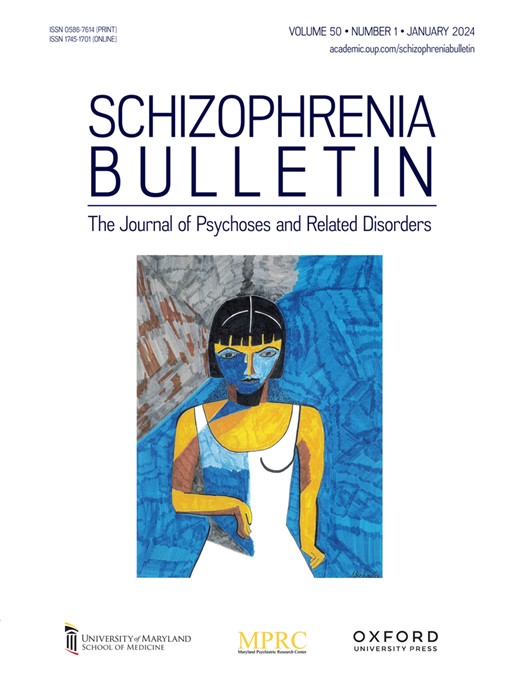奖励与精神病维度的神经反应
IF 4.8
1区 医学
Q1 PSYCHIATRY
引用次数: 0
摘要
背景与假设动机驱动、强化学习和奖励预测的缺陷与精神障碍有关。脑电图(EEG)测量这些过程已证明与精神障碍不一致的关系。本研究解决了文献中的主要局限性,并检查了多种脑电图神经反应与奖励和不同精神病维度之间的关系。研究设计样本包括362名成年人(年龄M = 49.87, 42.3%为女性):169名有精神障碍住院史,193名人口统计学上没有精神障碍史。参与者完成了一项货币猜测任务,我们测量了时域奖励积极性(RewP)以及赢时的时间-频率δ活动和输时的θ活动。参与者还完成了临床访谈、问卷调查和神经心理学测量。研究结果分类分析表明,RewP在组间没有差异,但患有精神分裂症或分裂情感障碍的参与者在赢和输方面的δ活动更迟钝。维度分析表明,更钝的RewP,赢的δ活动和输的θ活动与更高的精神病维度得分有关。更钝的三角洲活动也与更高的低阶脱离和高阶一般精神病理学维度得分有关。执行功能介导了δ和θ活动与精神病维度之间的关系。结论脑电时域和时频神经反应迟钝与精神病的维度表征有关。该研究还强调了在检查神经对奖励和精神病的反应时认知缺陷的重要性。本文章由计算机程序翻译,如有差异,请以英文原文为准。
Neural Responses to Reward and Psychosis Dimensions
Background and Hypothesis Deficits in motivational drive, reinforcement learning, and reward prediction have been implicated in psychotic disorders. Electroencephalography (EEG) measures of these processes have demonstrated inconsistent relationships with psychotic disorders. The present study addressed key limitations in the literature and examined the association between multiple EEG neural responses to reward and different psychosis dimensions. Study Design The sample included 362 adults (age M = 49.87, 42.3% female): 169 with a history of hospitalization for a psychotic disorder and 193 demographically matched with no history of a psychotic disorder. Participants completed a monetary guessing task, and we measured the time-domain reward positivity (RewP) as well as time-frequency delta activity to win and theta activity to loss. Participants also completed clinical interviews, questionnaires, and neuropsychological measures. Study Results Categorical analyses indicated no group differences in the RewP, but participants with schizophrenia or schizoaffective disorder had more blunted delta activity to win and theta activity to loss. Dimensional analyses indicated more blunted RewP, delta activity to win, and theta activity to loss were associated with greater psychosis dimension scores. More blunted delta activity to win was also associated with greater lower-order detachment and higher-order general psychopathology dimension scores. Executive functions mediated the relationship between both delta and theta activity and the psychosis dimension. Conclusions Blunted EEG time-domain and time-frequency neural responses to reward are associated with dimensional representations of psychosis. The study also highlights the importance of cognitive deficits when examining the neural response to reward and psychosis.
求助全文
通过发布文献求助,成功后即可免费获取论文全文。
去求助
来源期刊

Schizophrenia Bulletin
医学-精神病学
CiteScore
11.40
自引率
6.10%
发文量
163
审稿时长
4-8 weeks
期刊介绍:
Schizophrenia Bulletin seeks to review recent developments and empirically based hypotheses regarding the etiology and treatment of schizophrenia. We view the field as broad and deep, and will publish new knowledge ranging from the molecular basis to social and cultural factors. We will give new emphasis to translational reports which simultaneously highlight basic neurobiological mechanisms and clinical manifestations. Some of the Bulletin content is invited as special features or manuscripts organized as a theme by special guest editors. Most pages of the Bulletin are devoted to unsolicited manuscripts of high quality that report original data or where we can provide a special venue for a major study or workshop report. Supplement issues are sometimes provided for manuscripts reporting from a recent conference.
 求助内容:
求助内容: 应助结果提醒方式:
应助结果提醒方式:


